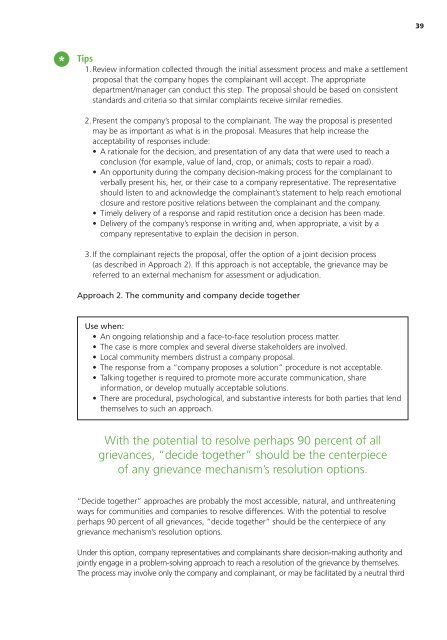A Guide to Designing and Implementing Grievance Mechanisms for ...
A Guide to Designing and Implementing Grievance Mechanisms for ...
A Guide to Designing and Implementing Grievance Mechanisms for ...
Create successful ePaper yourself
Turn your PDF publications into a flip-book with our unique Google optimized e-Paper software.
*<br />
Tips<br />
1.Review in<strong>for</strong>mation collected through the initial assessment process <strong>and</strong> make a settlement<br />
proposal that the company hopes the complainant will accept. The appropriate<br />
department/manager can conduct this step. The proposal should be based on consistent<br />
st<strong>and</strong>ards <strong>and</strong> criteria so that similar complaints receive similar remedies.<br />
2.Present the company’s proposal <strong>to</strong> the complainant. The way the proposal is presented<br />
may be as important as what is in the proposal. Measures that help increase the<br />
acceptability of responses include:<br />
• A rationale <strong>for</strong> the decision, <strong>and</strong> presentation of any data that were used <strong>to</strong> reach a<br />
conclusion (<strong>for</strong> example, value of l<strong>and</strong>, crop, or animals; costs <strong>to</strong> repair a road).<br />
• An opportunity during the company decision-making process <strong>for</strong> the complainant <strong>to</strong><br />
verbally present his, her, or their case <strong>to</strong> a company representative. The representative<br />
should listen <strong>to</strong> <strong>and</strong> acknowledge the complainant’s statement <strong>to</strong> help reach emotional<br />
closure <strong>and</strong> res<strong>to</strong>re positive relations between the complainant <strong>and</strong> the company.<br />
• Timely delivery of a response <strong>and</strong> rapid restitution once a decision has been made.<br />
• Delivery of the company’s response in writing <strong>and</strong>, when appropriate, a visit by a<br />
company representative <strong>to</strong> explain the decision in person.<br />
3.If the complainant rejects the proposal, offer the option of a joint decision process<br />
(as described in Approach 2). If this approach is not acceptable, the grievance may be<br />
referred <strong>to</strong> an external mechanism <strong>for</strong> assessment or adjudication.<br />
Approach 2. The community <strong>and</strong> company decide <strong>to</strong>gether<br />
Use when:<br />
• An ongoing relationship <strong>and</strong> a face-<strong>to</strong>-face resolution process matter.<br />
• The case is more complex <strong>and</strong> several diverse stakeholders are involved.<br />
• Local community members distrust a company proposal.<br />
• The response from a “company proposes a solution” procedure is not acceptable.<br />
• Talking <strong>to</strong>gether is required <strong>to</strong> promote more accurate communication, share<br />
in<strong>for</strong>mation, or develop mutually acceptable solutions.<br />
• There are procedural, psychological, <strong>and</strong> substantive interests <strong>for</strong> both parties that lend<br />
themselves <strong>to</strong> such an approach.<br />
With the potential <strong>to</strong> resolve perhaps 90 percent of all<br />
grievances, “decide <strong>to</strong>gether” should be the centerpiece<br />
of any grievance mechanism’s resolution options.<br />
“Decide <strong>to</strong>gether” approaches are probably the most accessible, natural, <strong>and</strong> unthreatening<br />
ways <strong>for</strong> communities <strong>and</strong> companies <strong>to</strong> resolve differences. With the potential <strong>to</strong> resolve<br />
perhaps 90 percent of all grievances, “decide <strong>to</strong>gether” should be the centerpiece of any<br />
grievance mechanism’s resolution options.<br />
Under this option, company representatives <strong>and</strong> complainants share decision-making authority <strong>and</strong><br />
jointly engage in a problem-solving approach <strong>to</strong> reach a resolution of the grievance by themselves.<br />
The process may involve only the company <strong>and</strong> complainant, or may be facilitated by a neutral third<br />
39





